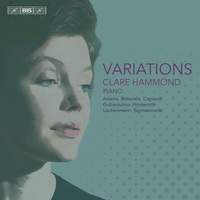Interview,
Clare Hammond on Variations
 Having made a name for herself as a specialist in contemporary repertoire, pianist Clare Hammond is perhaps uniquely placed to present a survey of variations from the twentieth and twenty-first centuries. It's a genre that, as she comments, has sometimes been seen as constrained – but in her capable hands, capturing the earnest, lyrical Romanticism of Szymanowski and the stark monochrome outlines of early Copland alike, it is anything but.
Having made a name for herself as a specialist in contemporary repertoire, pianist Clare Hammond is perhaps uniquely placed to present a survey of variations from the twentieth and twenty-first centuries. It's a genre that, as she comments, has sometimes been seen as constrained – but in her capable hands, capturing the earnest, lyrical Romanticism of Szymanowski and the stark monochrome outlines of early Copland alike, it is anything but.
I spoke to Clare about the sets of variations she's included on this album, and the different ways they approach the fundamental theme of mutating a given theme or idea.
On this album you draw together a huge variety, as it were, of variations – approaching the basic concept in many different ways. Where did the idea first come from for the album – is it an adaptation of an existing recital-programme?
I first came across Szymanowski’s Variations and Gubaidulina’s Chaconne and was struck by how they use the same formal principle (repetition of a single melody or theme) to radically different effect. The Szymanowski is firmly within the Romantic, bravura style of writing and his variations progress as a series of images, similar in tone and style to Mussorgsky’s Pictures at an Exhibition. In Gubaidulina’s Chaconne, repetition is much more tightly ingrained and contributes to a feeling of accumulation throughout the work. Although the piece only lasts nine minutes, its apotheosis is immense. She manages to forge an astonishingly original perspective on a form that can easily descend into cliché.
I then decided to explore sets of less well known variations from the twentieth and twenty-first centuries, not a period we instinctively associate with variation form. I was fascinated to see how composers respond to its strict limitations and transcend it in myriad ways.
Recordings of sets of variations (this one included) often seem to be accompanied by a comment fighting the genre’s corner against accusations of being repetitive or limited. Such a reputation is hardly deserved – why do you think the idea of variations being dull remains so prevalent, despite so much counter-evidence?
Of course we have counter-evidence in the form of Bach’s Goldberg Variations, Elgar’s Enigma or Beethoven’s Diabelli, but these are exceptions within the genre. Essentially, variations consist of one theme that is repeated continually until the piece ends. There are plenty of variations in print, which may not reach the concert stage very often, that remain firmly within the bounds of the form and fail to move us emotionally. The sets that we know best are those where a composer breaks free of these restraints, emotionally and dramatically if not formally, and really creates something new.
Several of these sets of variations imply an autobiographical element – certainly the Hindemith and arguably also the Lachenmann. How much of a tradition is there of composers expressing their inner feelings through this genre, rather than through chamber music as is more widely discussed?
I am not sure whether there is a great difference in how composers express their inner feelings dependent on genre. The means may be different, but I think the very act of writing music is one of self-expression. Whether that is concrete and autobiographical, or diffuse and abstract, is another question.
The early Copland Variations occupy a very different soundworld from his well-known later orchestral works – why did he take such a different stylistic direction and abandon this austere modernist sound?
I am sure that that there were many different currents, but two key motivations at this time were a desire to cultivate a wider audience and a growing interest in Anglo-American folk music. The latter expanded to encompass Mexican folk styles in El Salón México, and ultimately African-American, Jewish and Latin American folk idioms. It is also worth noting that he returned to a more abstract twelve-tone period later in life, so the austere modernism of the Piano Variations was something that continued to fascinate him.
Whereas with more traditional sets of variations the melody or harmony can be traced throughout the set, contemporary takes on the genre often take a freer approach. How do you create that sense of a unified whole when performing a set of variations that may seem quite distant in their relation to each other?
It can be very challenging, and was something that I grappled with at length in Birtwistle’s Variations from the Golden Mountain. I spent a long time trying to identify the theme, find common elements and trace those through the work, with very little success. Ultimately, I decided the best course of action was to imagine the piece from a listener’s perspective and provide clear points of articulation and repose. In the absence of more obvious formal signposts, it took far longer to mould these variations than the other pieces on the disc. There was something very satisfying, however, in sensing the architecture of the piece gradually coalesce and it was a strangely organic process.
Clare Hammond (piano)
Available Formats: SACD, MP3, FLAC, Hi-Res FLAC



